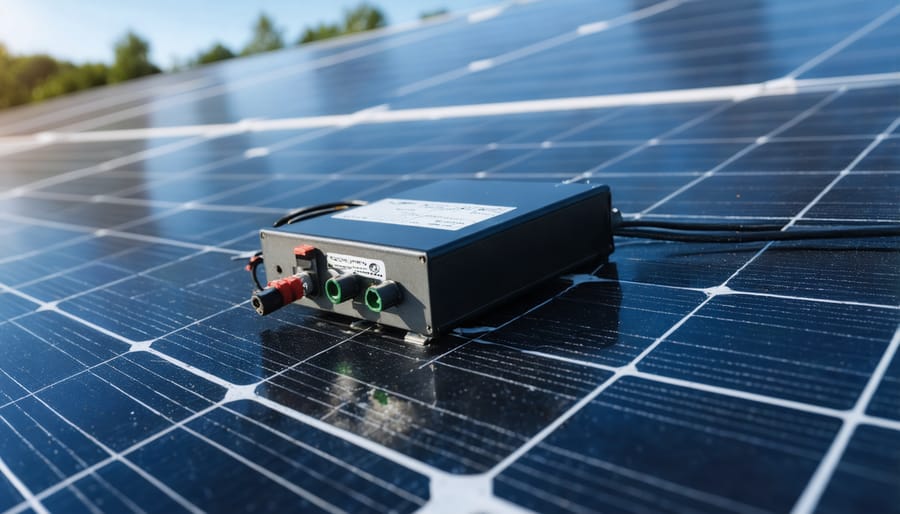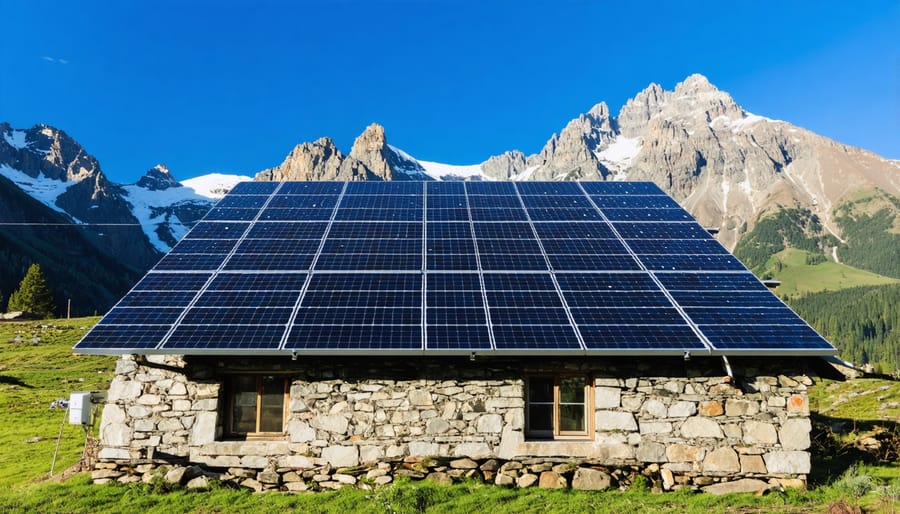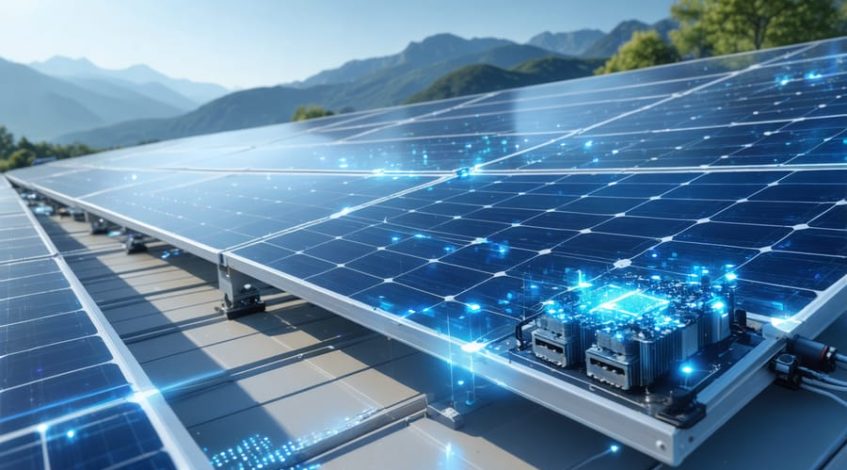Off-grid solar micro inverters are revolutionizing distributed energy systems by enabling individual panel optimization and enhanced energy independence. These sophisticated power electronics convert DC electricity from single solar panels into grid-compliant AC power, offering unprecedented control and efficiency in standalone power systems. Unlike traditional string inverters, micro inverters maximize energy harvest by eliminating the “weakest link” effect, where shaded or underperforming panels reduce overall system output. For business owners and facility managers seeking reliable off-grid solutions, micro inverters provide superior monitoring capabilities, enhanced safety through low-voltage DC architecture, and simplified system scaling. Their modular design allows for strategic implementation across various commercial applications, from remote telecommunications stations to agricultural operations, while maintaining optimal performance even in challenging environmental conditions.
Understanding Off-Grid Solar Micro Inverters
How Micro Inverters Differ from String Inverters
Micro inverters and string inverters represent two distinct approaches to converting DC power from solar panels into usable AC power. While string inverters operate by connecting multiple solar panels in series to a single central inverter, micro inverters function independently at each individual panel.
A key distinction lies in their operational flexibility. Micro inverters allow each solar panel to perform at its maximum potential, regardless of other panels’ performance. This panel-level optimization proves particularly valuable in off-grid applications where consistent power generation is crucial. In contrast, string inverters can experience reduced overall system output if one panel underperforms due to shade, debris, or damage.
From a monitoring perspective, micro inverters provide granular performance data for each panel, enabling precise system optimization and maintenance. String inverters, while more economical initially, offer only system-level monitoring, making it challenging to identify specific panel issues in larger installations.
Reliability in off-grid scenarios favors micro inverters, as a single component failure affects only one panel rather than the entire array. This redundancy ensures continued power generation, albeit at a reduced capacity. Additionally, micro inverters typically offer higher energy harvest rates, with studies showing up to 5-25% better energy production in challenging conditions.
While micro inverters generally carry a higher upfront cost, their enhanced performance, simplified maintenance, and superior reliability often justify the investment for off-grid applications where power consistency is paramount.

Key Components and Functionality
Off-grid solar micro inverters consist of several essential components that work together to convert and manage solar power effectively. At the core is the DC-to-AC conversion unit, which transforms the direct current generated by individual solar panels into grid-compatible alternating current. Each micro inverter includes Maximum Power Point Tracking (MPPT) technology, optimizing power output under varying conditions.
The system incorporates sophisticated monitoring circuits that provide real-time performance data and fault detection capabilities. Built-in communication modules enable remote system monitoring and maintenance through wireless connectivity. Advanced safety features include rapid shutdown capabilities and ground fault protection circuits, ensuring compliance with electrical codes.
The power management unit coordinates energy flow between solar panels, battery storage systems, and household loads. An intelligent switching mechanism automatically manages power distribution, while the thermal management system maintains optimal operating temperatures. Anti-islanding protection prevents power feedback into the grid during outages, making these systems particularly suitable for off-grid applications.
Quality micro inverters also feature robust weatherproof enclosures, typically rated IP67 or higher, protecting internal components from environmental factors while ensuring long-term reliability.

Benefits for Microgrid Applications
Enhanced System Reliability
Off-grid solar micro inverters significantly enhance system reliability through their distributed architecture. Unlike traditional string inverters, where a single point of failure can affect an entire solar array, micro inverters operate independently at each panel. This redundancy ensures that if one inverter malfunctions, the rest of the system continues to generate power efficiently.
The modular nature of micro inverters is particularly valuable in microgrid applications, where consistent power output is crucial. Each panel-inverter pair functions as an autonomous unit, eliminating the cascade effect of failures common in centralized systems. This design also simplifies maintenance and troubleshooting, as technicians can quickly identify and replace malfunctioning units without disrupting the entire system’s operation.
Modern micro inverters incorporate advanced monitoring capabilities, allowing real-time performance tracking and predictive maintenance. This proactive approach to system management helps prevent potential issues before they impact power generation, ensuring maximum uptime and optimal return on investment for business operations.
Optimized Energy Production
Micro inverters excel in maximizing energy production through their panel-level optimization capabilities. Unlike traditional string inverters, micro inverters allow each solar panel to operate independently, ensuring optimal performance even when individual panels face shading, debris, or orientation variations. This panel-level management typically results in 5-25% higher energy yield compared to traditional systems.
The technology employs Maximum Power Point Tracking (MPPT) for each panel individually, continuously adjusting voltage and current to maintain peak efficiency regardless of environmental conditions. This granular control ensures that the underperformance of one panel doesn’t affect the entire array’s output, a common limitation in string inverter systems.
Real-world data shows that off-grid micro inverter installations consistently achieve higher energy harvest during early morning and late afternoon hours, when light conditions are less than optimal. The systems also demonstrate superior performance in partial shading scenarios, maintaining up to 95% efficiency even when portions of panels are obstructed by trees, buildings, or cloud cover.
System monitoring capabilities provide detailed performance data for each panel, enabling precise optimization and rapid identification of any efficiency issues.
Scalability and Flexibility
Off-grid solar micro inverters offer exceptional scalability, allowing system expansion without overhauling the entire installation. Users can start with a modest setup and incrementally add panels and micro inverters as energy needs grow or budget permits. This modular approach provides significant flexibility in system design, enabling customization for various roof configurations and space constraints.
The plug-and-play nature of micro inverters facilitates straightforward system modifications, making it easier to replace individual components or expand capacity without disrupting the entire array. Each micro inverter operates independently, ensuring system reliability during upgrades or maintenance. This adaptability is particularly valuable for businesses and organizations anticipating future growth or varying seasonal energy demands.
For optimal performance, most micro inverter systems can accommodate up to 20-25 panels per branch circuit, with multiple branches easily integrated into larger installations. This scalability ensures long-term value and investment protection while maintaining system efficiency.
Implementation Considerations
Cost Analysis and ROI
Investing in off-grid solar micro inverter systems represents a strategic cost-effective energy solution with compelling long-term returns. Initial system costs typically range from $2,500 to $5,000 per kW installed, depending on system size and complexity. However, this investment is offset by several financial benefits.
The ROI calculation must consider multiple factors: energy cost savings (averaging 20-30% annually), reduced maintenance requirements compared to string inverters, and increased system efficiency (up to 96%). Most installations achieve payback periods between 4-7 years, with system lifespans extending to 20-25 years.
Key financial advantages include:
– Elimination of utility bills in fully off-grid systems
– Enhanced energy harvest (5-10% higher than traditional inverters)
– Lower replacement costs due to modular design
– Reduced maintenance expenses
– Potential tax incentives and renewable energy credits
A typical 10kW commercial installation costs approximately $35,000-$45,000, including equipment and installation. Annual energy savings can range from $3,000-$4,500, depending on local electricity rates. When factoring in maintenance savings and increased system efficiency, the total ROI often exceeds 200% over the system’s lifetime.
For optimal financial planning, organizations should consider financing options, available incentives, and scalability requirements to maximize their investment return while ensuring system reliability and performance.
Installation Requirements
Proper installation of off-grid solar micro inverters requires careful attention to technical specifications and safety standards. The mounting location must be sheltered from direct sunlight and precipitation, with ambient temperatures maintained between -20°C and 45°C. A minimum clearance of 20cm around all sides of the micro inverter is essential for adequate ventilation.
The installation surface should be fire-resistant and capable of supporting the system’s weight. Each micro inverter typically requires a dedicated circuit breaker rated at 20A per unit. The AC branch circuit must use 12 AWG copper conductors, while DC connections require specialized MC4 connectors rated for solar applications.
Grounding requirements include a continuous copper conductor (minimum 6 AWG) connected to the building’s grounding electrode system. The installation must comply with NEC Article 690 for photovoltaic systems and local electrical codes. Professional certification is typically required for installation, and the system should include rapid shutdown capabilities as mandated by NEC 2017 requirements.
An internet connection is recommended for remote monitoring capabilities, with a minimum upload speed of 1 Mbps. Documentation of array layout, inverter serial numbers, and panel mapping is essential for maintenance and warranty purposes.
Real-World Applications
Commercial Success Stories
Several notable commercial installations demonstrate the effectiveness of off-grid solar micro inverter systems across diverse applications. In California’s Mojave Desert, the Joshua Tree Eco-Resort successfully implemented a 50kW system featuring 200 micro inverters, achieving complete energy independence while reducing operational costs by 75% within the first year.
The Remote Communities Initiative in Alaska showcases another impressive implementation, where micro inverter systems were deployed across 15 isolated villages. These installations have maintained a 99.8% uptime rate even in extreme weather conditions, providing reliable power to over 2,000 residents and reducing diesel dependency by 60%.
In the agricultural sector, Australian company Green Farms Corporation equipped their 200-acre facility with micro inverter-based solar systems. The installation powers irrigation systems, processing facilities, and cold storage units, resulting in annual energy savings of $180,000 and a carbon footprint reduction of 450 metric tons.
The Mountain View Data Center in Colorado represents a groundbreaking commercial application, utilizing micro inverters in a 200kW solar array to support critical backup power systems. This implementation has demonstrated 30% higher energy yield compared to traditional string inverter systems and achieved ROI within 4.5 years.
These success stories highlight the versatility, reliability, and economic viability of off-grid solar micro inverter systems across different commercial applications and environmental conditions.
Remote Location Deployments
Remote location deployments of off-grid solar micro inverters have proven instrumental in bringing reliable power to areas where traditional grid infrastructure is impractical or cost-prohibitive. These systems are particularly valuable in mining operations, agricultural facilities, research stations, and remote communities.
In the Australian Outback, several mining companies have implemented micro inverter systems to power their operational facilities and worker accommodations. These installations typically combine 20-30 solar panels, each equipped with its own micro inverter, providing consistent power throughout the intense desert conditions while requiring minimal maintenance.
Remote research stations in Antarctica have also adopted micro inverter technology, capitalizing on their ability to continue functioning even if individual units are affected by extreme weather. The McMurdo Station’s supplementary power system utilizes micro inverters specifically designed for cold-weather operation, demonstrating their versatility in harsh environments.
Indigenous communities in Northern Canada have successfully deployed micro inverter systems to power essential services. The Pikangikum First Nation community installation serves as a prime example, where 100 buildings were equipped with individual solar arrays and micro inverters, significantly reducing diesel generator dependence.
Telecommunications companies frequently employ micro inverter systems for remote cell towers and repeater stations. These installations typically feature 4-8 panel configurations, providing reliable power while enabling remote monitoring capabilities, ensuring continuous operation with minimal on-site maintenance requirements.

Off-grid solar micro inverters represent a pivotal advancement in distributed energy systems, offering unprecedented flexibility and efficiency for standalone power solutions. As technology continues to evolve, we can expect further improvements in efficiency ratings, storage integration capabilities, and smart monitoring features. The growing demand for sustainable energy solutions, coupled with decreasing component costs, positions micro inverters as an increasingly attractive option for businesses and organizations seeking energy independence. Future developments will likely focus on enhanced power optimization, improved weather resistance, and seamless integration with emerging smart grid technologies. For decision-makers considering off-grid solar solutions, micro inverters provide a scalable, reliable, and future-proof investment that aligns with both environmental responsibility and operational efficiency goals.

